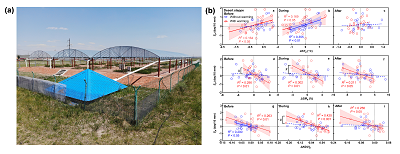Phenological sensitivity is a key indicator to quantify phenological response and assess the vulnerability of different types of species and vegetation to climate change. Most previous studies have focused on the sensitivity of phenology to temperature, however, under the current complex rainfall change scenario, the sensitivity of plant phenology to rainfall change and whether it is regulated by climate warming is unclear.
Field control experiments are an important means to explore the response mechanism of ecosystems to climate change. However, there is a large uncertainty in the results of control experiments at a single experimental site (or a single type of ecosystem) when extrapolated up to the regional or global scale. Therefore, simultaneous control experiments in multiple ecosystem types are essential to fully understand and assess ecosystem response patterns at regional scales under climate change.
Based on the above problems, this study selects three types of temperate grasslands along the natural rainfall gradient in Xilin Golmeng, Inner Mongolia Autonomous Region, namely, desertification grassland, typical grassland and meadow grassland. Eighteen untouched soil blocks were dug up for each type of grassland, each measuring 2.2 m (long) × 1.5 m (wide) × 1.2 m (height). The four sides and bottom of each unformed soil block were fixed with steel plates and transported to the Restoration Ecology Experimental Demonstration Research Station of the Institute of Botany, Chinese Academy of Sciences in Duolun County. After arranging all the soil blocks according to the experimental design and burying them in the soil, using a canopy to isolate natural rainfall, climate warming (nighttime warming) and rainfall pattern changes (increasing or decreasing rainfall by 30%) were treated.

Experimental sample map (a); Relationship between rainfall sensitivity and impact factors in desertification grasslands (b)
After four years of phenological observations (2015-2018), it was found that the phenology of the three grassland plants was symmetrical in sensitivity to reducing and increasing rainfall. In addition, climate warming significantly increased the rainfall sensitivity of flowering phenology in desertified grasslands, but had no effect on the rainfall sensitivity of flowering phenology in typical grasslands and meadow steppe. Compared with the control, the dependence of rainfall sensitivity on soil moisture and vegetation growth index in the middle of flowering was significantly enhanced under warming treatment, suggesting that water availability and vegetative growth in the middle of reproduction have an important regulatory effect on rainfall sensitivity. This study also measured the carbohydrate content of leaves during the flowering period, which further supports these conclusions. On the one hand, the results of this study provide key basic data for the rainfall sensitivity of different types of temperate grasslands under climate change, and improve the prediction ability of the model on the response of regional-scale reproductive phenology to future simultaneous climate warming and rainfall pattern change scenarios. On the other hand, it is proved that water availability and vegetative growth in the middle period of plant reproductive phenology are particularly important for regulating rainfall sensitivity of propagation phenology under climate warming scenarios, and this paper provides new ideas for understanding the change mechanism of phenological sensitivity under the action of multiple climate change drivers.

